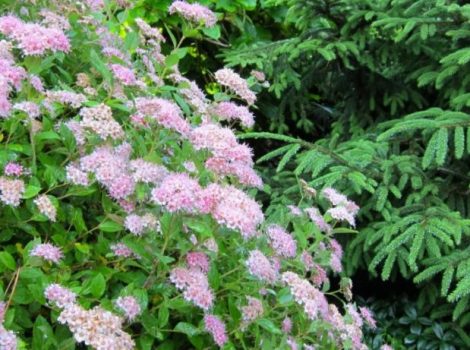Content
Beetroot is one of the most famous vegetables and has been known for a long time. To get a good harvest of these root crops suitable for winter storage, you need to choose the right varieties. There are quite a few varieties of beets, and when choosing, you need to take into account that they are divided according to ripening times, adaptability to a particular climate, soil and other characteristics of the culture.
Only the best beets can be used to make delicious salads, soups, borscht, snacks, vinaigrettes and pickles.
Beets are divided into 3 groups according to the ripening period, these are: early, medium, late.
The best dark red beets without light rings
Early varieties
Early varieties of beets allow you to feast on a variety of dishes from this delicious vegetable in the summer, immediately after harvesting the fruit. The vegetable can be consumed without heat treatment. Sowing of seeds in such varieties occurs earlier than others, and harvesting occurs in 75-110 days.
Bordeaux 237
 Bordeaux 237
Bordeaux 237
It belongs to one of the most famous cold-resistant beet varieties. Ripening of this variety occurs in 99-120 days. Fruits are medium in size, round in shape. The taste is pleasant, sweet, characteristic of this vegetable. The pulp is dark red. When frozen, taste is not lost. Beets with a long shelf life (more than six months). Suitable for sowing before winter. Not susceptible to damage by pests, diseases.
Modana
 Modana variety
Modana variety
Modana red beet has a neat and beautiful round shape. A variety without light rings. The color of the variety is dark, burgundy-cherry. Weight reaches 130-260 grams. The pulp is pleasant to the taste, sweetish. Grown with seedlings. From the moment of planting young plants to harvest, 68-85 days pass. The variety is cold-resistant, unpretentious, disease-resistant. Suitable for bundling and recycling. It is not stored for long.
Pablo F1
 Pablo variety
Pablo variety
Early ripe, sweet variety. The fruits are round in shape. The size is the same. Weight 195-380 grams. The skin is thin. Root crop without light rings. The pulp is rich in color, dark red. Fruit collection is uneven, starting from 85-95 days. The variety is stable, it can be stored for several months. Dark varieties of beets are ideal for making vinaigrette.
Bohemia
Bohemian variety
Refers to dark varieties of beets. The shape is round. The color is even, dark burgundy. A variety without light rings. The taste is sweet, delicate and very juicy. Root crops ripen in 77-83 days. Beets of this variety are resistant to diseases and are well stored. Does not lose its appearance, taste during storage.
Detroit
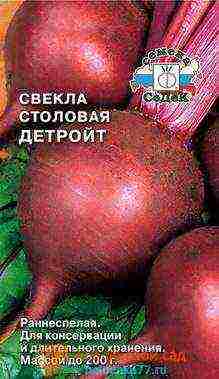 Detroit variety
Detroit variety
Cold-resistant, early ripening variety. It does not freeze during spring frosts. The plant, during active growth, is demanding for watering. Red beets without light rings. The fruits are small and small. Weight reaches 210 grams.
The shape is neat and round. The harvest is massive, it starts on the 105-110 day. The variety is not susceptible to disease. When feeding, the size of the fruit increases.
Boltardi
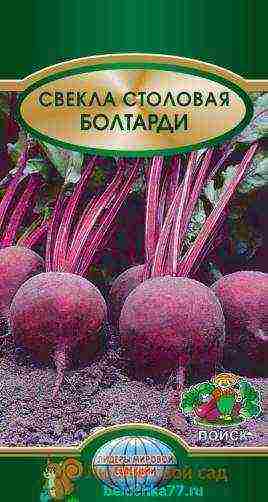 Boltardi variety
Boltardi variety
An early, high-yielding, cold-resistant variety. Root crops are frost-resistant. The pulp is juicy, tasty, dark red in color. Radial rings are visible on the cut. Average weight 160 grams.Fruits are smooth, neat, rounded.
The variety is well stored, not afraid of frost, resistant to most diseases. When sowing under cover in spring, it is suitable for bunch harvesting. With late sowing, the harvested crop can be stored for the winter for 3-5 months.
Egyptian flat
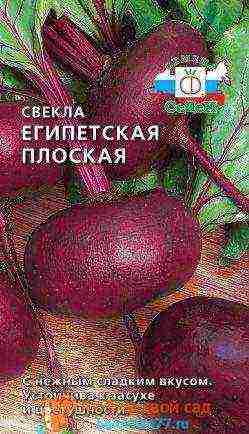 Grade Egyptian flat
Grade Egyptian flat
It is famous for its large (more than 500 grams) fruits. The pulp is purple-burgundy. Small radial circles are visible. The taste is sweet, juicy, ideal for vinaigrette. Ripening in the Egyptian flat variety occurs in 90-100 days. The variety is drought-resistant, stored for more than six months.
Mona variety
 Mona variety
Mona variety
One-sprout, grown from seedlings. Cylindrical beets. Weight reaches 300 grams. Harvesting is done in 105-115 days. Beets of this variety are suitable for bundling and processing.
Medium varieties
These varieties easily tolerate sowing for the winter. Summer drought does not harm fruit formation. Shelf life is longer than that of earlier varieties. Mid-season varieties are divided into several types and when choosing seeds, all the characteristics of the variety must be taken into account.
Borsch
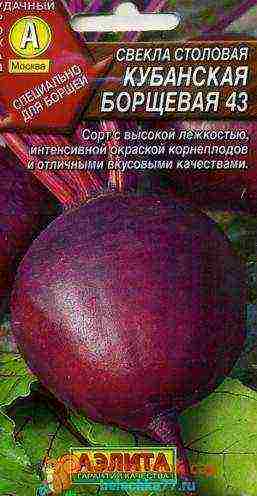 Variety Borshchivaya
Variety Borshchivaya
Borscht beet is suitable for growing on any soil. The pulp is pleasant to the taste, soft, dark raspberry color. No light rings. Small white radial circles sometimes appear. Fruits are of the same size, small. Fruit weight 230-500 grams. The skin is thin. Ripen in 98-104 days.
With good feeding, up to 9 kilograms of fruit are removed from a square meter. Can be sown in summer and before winter. Suitable for preparing vegetable juices, first courses, snacks, salads.
Delicacy
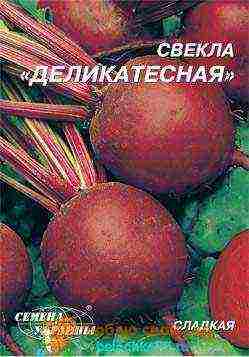 Delicacy variety
Delicacy variety
Delicacy beets are versatile and cold-resistant varieties. Fruits of the Delikatesnaya variety are used for cooking, preparing various dishes, preparations, and fresh consumption.
Maturation occurs on day 95. Small beets. The shape is round. The skin is smooth, thin. Beets are dark varieties and have dark cherry flesh. There are no radial rings.
With growth, several shoots begin to bloom, this practically does not affect the yield. The vegetable is stored for a long time. Versatile to use. The variety is suitable for central Russia, grows well in cool weather.
Opolskaya
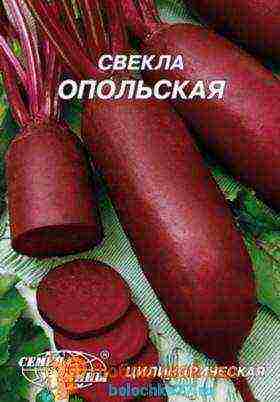 Beetroot Opolskaya
Beetroot Opolskaya
Mid-season, moisture-loving variety. The shape of the fruit is oblong. The skin is thin. The taste is slightly sweet. Thin rings are visible on the cut. At the beginning of growth, the variety is demanding for timely, abundant watering. Shelf life up to six months. The commercial quality and taste do not change during storage.
Incomparable А 463
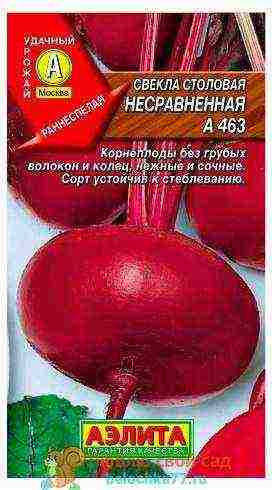 Grade Incomparable А 463
Grade Incomparable А 463
It is a high-yielding, unpretentious beet variety. The fruits are large, flat-round in shape. The top is red-gray. The pulp is dark cherry, tasty, juicy. A variety without light rings. Up to 9 kilograms of fruit can be removed from a square meter.
The crop easily tolerates wintering, does not lose its qualities. The growing season lasts 100 days. Beets of this variety are not damaged by pests or diseases.
Mulatto
 Variety Mulatka
Variety Mulatka
Differs in tasty and large fruits. Spherical beets. Weight reaches 500 grams. The pulp is uniform red, without light rings, soft, tasty. The color does not change during cooking. The harvest is stored throughout the winter.
Harvesting is done 115-120 days after sowing. Up to 7.5 kilograms of fruit are removed from one meter. Early plantings can be sold in bunches.
Cold resistant 19
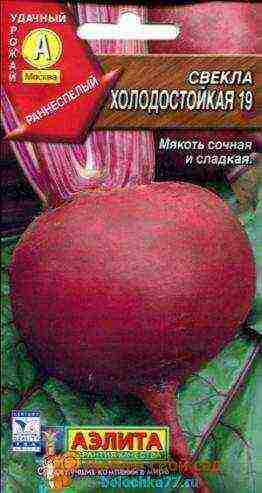 Cold-resistant grade 19
Cold-resistant grade 19
Cold hardy, medium early variety. The technical ripeness of root crops occurs in 65-76 days. The shape is flattened round. The color of the beets is dark red. The skin is smooth. Weight 150 - 230 grams. The pulp is very tasty, juicy, tender. The variety is suitable for bunch cultivation. The keeping quality of the fruit is good. You can sow in spring and before winter.
Noblewoman
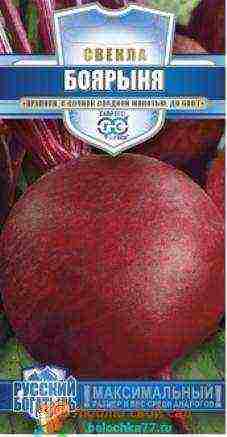 Variety Boyarynya
Variety Boyarynya
High-yielding and mid-season variety. The root crop is spherical. Weight 210-350 grams. With timely feeding, it increases.
Late varieties
These varieties have a long growing period. They are resistant to frost in spring and autumn and heat in summer. Vegetables are stored in a cool place until the next harvest. The loss of mass and appearance is insignificant.
Renova
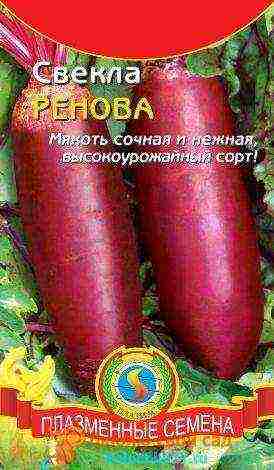 Renova variety
Renova variety
Renova beets are famous for their abundant harvest. The shape is cylindrical. The skin is thin, dark pink. The pulp is red-violet. The fruit does not have a beetroot smell. The taste is pleasant. Fruit weight reaches 390 grams. The variety is cold-resistant and undemanding to the climate and growing conditions.
One-sprout
 Single-sprout variety
Single-sprout variety
The single-sprout variety, with good care, allows you to remove up to a ton of root crops from a hundred square meters of land. From the moment of seed germination to full maturity of the fruit, 130 days pass. In a cool place, the vegetable is stored for up to six months. Average weight 450-550 grams.
The taste is pleasant, juicy. The pulp is dark burgundy. The skin is thin. The shape is flat-round. You can use cassettes for growing seedlings. The variety is not susceptible to disease.
Cylinder
 Cylindra grade
Cylindra grade
Cylinder red beet got its name from its cylindrical shape. The plant is cold and heat resistant. Ripens in 101-120 days. Up to 120 kilograms of fruits are collected from a hundred. The size of the roots is small. But with good care it reaches 700 grams. Length 25-32 centimeters.
The taste is pleasant, juicy, odorless. The color is bright, without light rings. The skin is thin. The harvested crop is stored for up to 9 months. Diseases, pests, frost and heat are not terrible for this variety.
Matron Zedek
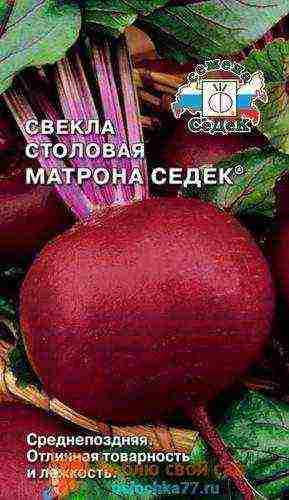 Matrona Sedek variety
Matrona Sedek variety
It is a late variety. Beets are dark varieties. Rings are weak. The shape of the fruit is flat-round. Weight reaches 300 grams. The taste is pronounced. The fruits are suitable for long-term storage, do not lose their qualities.
Citadella
 Citadella variety
Citadella variety
Red beet Citadela is a late-ripening variety. Average length. The shape is cylindrical. The pulp is bright, without light rings. The taste is beetroot. If stored properly, it lasts until May. The appearance and taste practically does not change.
You can also distinguish varieties: Belushi F1, Vinaigrette, Red Ruby, Bikores, Wodan F1, Two-seeded TSKHA, Bolivar, Crimson ball, Nohovski, Tsarina F1, Cold-resistant, Bettollo F1, Bona, Bordeaux single-seeded, Globus, Boro F1, Zhukovchanka, Libero, Subeto F1, Madam, Ideal, Demeter. They are distinguished by excellent taste and versatility in use.
Varieties for the Moscow region
For central Russia, you can choose quite a few varieties of beets, which, with proper care, give an excellent harvest of high-quality root crops.
Early varieties for the Moscow region include: Red ball, Wodan, Detroit, Pushkinskaya flat, Bordeaux-237, Boltardiran, Gribovskaya flat, Mulatka, Slavyanka. Beets of these varieties ripen in 2.5-3.5 months.
Red ball
 Variety Red ball
Variety Red ball
Early, dietetic variety. Sowing is done in early spring. Harvesting begins in 68-72 days. Root weight 150-250 grams. The pulp is very juicy, dark red. Cut rings are weak. 3-6 kilograms of root crops are removed from a square meter.
Wodan F1
 Variety Wodan F1
Variety Wodan F1
An early, high-yielding hybrid variety. The hybrid ripens in 78-82 days. The shape is round, smooth, the tail is thin. The color is dark red, without light rings. Root weight 220-500 grams. The taste is pronounced, juicy.
The best medium varieties: Eclipse, Bohemia, Egyptian flat, Donskaya flat, A-463, Bona, Cold-resistant-19, Matrona, Monocle, Patrick. Root crops are resistant to cold and drought. Stored well.
Eclipse variety
Mid-season. Beets have an elongated oval-cylindrical shape with a blunt, round or slightly curved shape. The pulp is red-violet, tender, juicy.
Late varieties include: Ataman, Podzimnyaya, Cylindra, Bordeaux single-seeded, Renova, Rocket, Bettina, Larka. The seeds of these varieties should be sown in late spring.
Variety Ataman
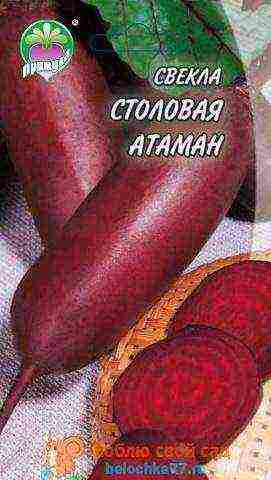 Variety Ataman
Variety Ataman
Medium late, ideal for the Moscow region. Easily tolerates frost, does not like dampness. Maturation occurs at 120-130 days. The shape is cylindrical.Fruit weight 200-300 grams. The color of the root crop is dark red. The pulp is tender and juicy without light rings. The taste is excellent. The variety is lazy.
The pulp of these varieties is tender and juicy. The fruits are not intended for long-term storage.
Varieties for the Urals
For the Urals, the best varieties are: Bikores, Valenta, Bon-Bon F1, Odnorostkovaya, Bravo, Crimson ball, Betina, Detroit 2, Boltardi, Scarlett suprim, Gribovskaya flat A-473, Bordeaux single-seeded, Bordeaux 237, Bona, Mulatka, Virovskaya single-seeded , Crimson Globe, Incomparable A-463, Podzimnyaya A-474, Rougette F1, Dark red round, Chrobry (Brave), Cold-resistant 19, Cylinder.
Dark variety One-sprout - early maturing and fruitful. The vegetative period is 80-130 days. A distinctive feature of the variety is one and two-seeded fruits. The shape is rounded flat or round. Weight 300-600 grams. The color is rich, dark burgundy. The pulp is tasty, juicy and tender. Stored for a long time.
Bikores
 Variety Bikores
Variety Bikores
is a fruitful, mid-season beet variety. Sweet variety. The color of the fruit is maroon. The shape is round, leveled. Weight 210-350 grams. The pulp is bright, without light rings, tasty, juicy. About 6 kilograms of fruits are harvested from a square meter.
Valent's variety
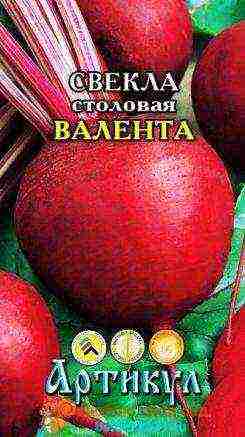 Valent's variety
Valent's variety
One-germ, grows in 95-100 days. Weight reaches 300 grams. The shape is oval-rounded. The pulp is sweet, tasty, dark red. The variety is dormant, cold-resistant, not afraid of diseases.
Bon-Bon F1
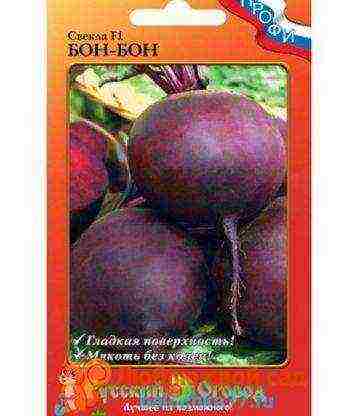 Variety Bon-Bon F1
Variety Bon-Bon F1
This is a medium-ripening beet variety. The growing season is 120 days. The flesh of the fruits is bright red, without light rings, tasty. The shape is round, with a thin skin. Sowing is carried out from April to mid-July.
These varieties easily tolerate sudden temperature changes and cool climates. With good care, the harvest is very abundant.
Harvesting is stretched until the end of September. For spring planting at the beginning of growth, it is recommended to use a covering material.
Varieties for Siberia
The most adapted for the Siberian climate are the varieties: Siberian flat, Podzimnyaya, Krasny ice, Mashenka, Krasny bogatyr, Odnorostkovaya, Incomparable, Bordeaux 327, Cold-resistant, Pablo, Cylinder.
Siberian Flat Beet
An early variety, ripens in 98-100 days. The shape is flat. Beets are dark and reddish-purple in color. Weight 200-400 grams. The taste is excellent. The variety is cold-resistant, disease-resistant.
Winter
 Podzimnyaya variety
Podzimnyaya variety
Medium early grade. The shape is round. Weight 200-400 grams. The color of the pulp is burgundy. The variety is cold-resistant, resistant to most diseases.
Red ice grade
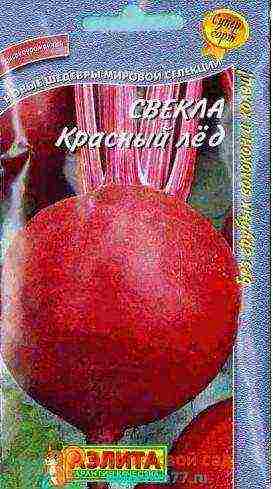 Red ice grade
Red ice grade
Ripens in 100 days. The pulp is bright, with small rings. The weight of root crops is 200–300 grams. 4-5.5 kilograms of beets are harvested from a square meter.
Red hero
High-yielding variety. The shape is cylindrical. The skin is thin, dark red. Pulp without rings. Weight 200-550 grams. Productivity from a square 8-10 kilograms.
Mashenka
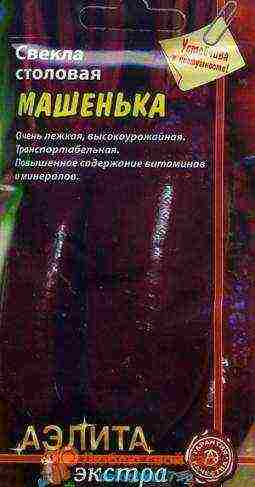 Variety Mashenka
Variety Mashenka
Mid-season and high-yielding variety. Dark red variety without light rings. The shape is cylindrical, smooth. Up to 9 kilograms of fruits are harvested from a meter. Fruit weight 310-600 grams. The fruits are delicious. The plant is not susceptible to disease.
Growing beetroot seedlings can increase the likelihood of a good harvest. The best option for planting is the cassette method. With this planting, 1 plant grows in a separate cell and planting and thinning is not required.
Under favorable conditions, an excellent harvest can be harvested by September - early October.
Quite often, in these regions, sowing is used before winter, when the ground is frozen, the seeds are placed in the beds, and in the spring, when the soil warms up, they quickly begin to grow.
Sweet varieties for central Russia, Moscow region, Siberia: a hybrid of Pablo, Detroit round, Incomparable, Cylinder.
Some of the most widely used and loved by gardeners varieties of the Urals and Siberia are: Red Ice, Bikores, Siberian flat, Mulatka, Krasny Bogatyr, Mondoro F1, Mashenka, Vital cylinder.
Dark varieties of beets are in great demand, suitable for preparing various snacks, juices, first and second courses, salads, and blanks.
All these varieties, with proper agrotechnical work, give an excellent yield of high-quality fruits.
Every gardener wants to plant and grow on his site exactly the best varieties of beets, the sweetest and most delicious.We will introduce you to such varieties and help you decide on the choice of ideal table or sugar beet varieties, their description and characteristics below.
Beets "Egyptian flat"
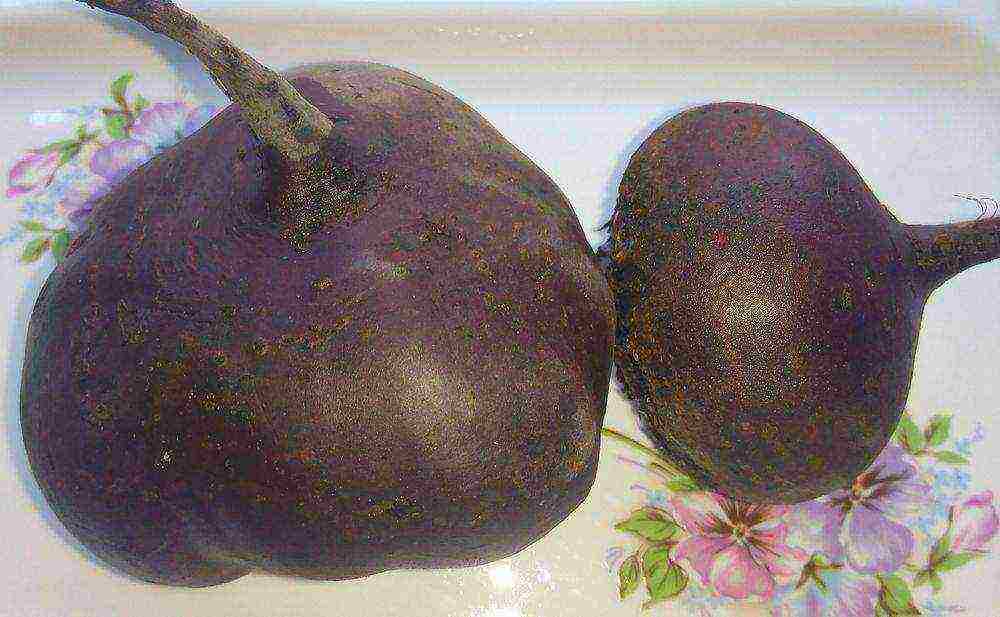
Almost every gardener knows such a wonderful variety as Egyptian flat beets. He belongs to the mid-early. From planting to harvesting, it can take from 95 to 130 days.
Sowing seeds is carried out from April to June, usually directly into the open ground. But planting is also possible for seedlings.
The seed is immersed in the soil to a depth of at least two centimeters. If the vegetable is planted in rows, then the distance between them is observed about twenty-five centimeters. Seedlings need to be thinned out. This is done for the first time when the first leaves appear on the surface. The operation is repeated when the fetus reaches four centimeters in diameter. It is advisable to loosen the soil for the culture regularly; additional fertilizing with fertilizers will also be useful. This beet variety is quite drought-resistant.
Fruits are claret-purple in color, rounded, flattened ellipsoid in shape. Beets taste very sweet, juicy and tender.
According to gardeners' reviews, this beet variety has excellent appearance and taste. The variety is resistant to flowering and tolerates drought satisfactorily. The size of the root crops reaches about 8 - 12 cm in diameter, and the weight is up to 500 grams. This is a fairly productive variety of beets - from 1 sq. m. can be collected from 3 to 8 kg. The size of the fruit will depend on the time of planting. It is better to produce it in several passes, then the beets will grow in different sizes.
You can see the harvest of the Egyptian flat beet, which has been stored for some time and in a section.

Beetroot "Bordeaux"
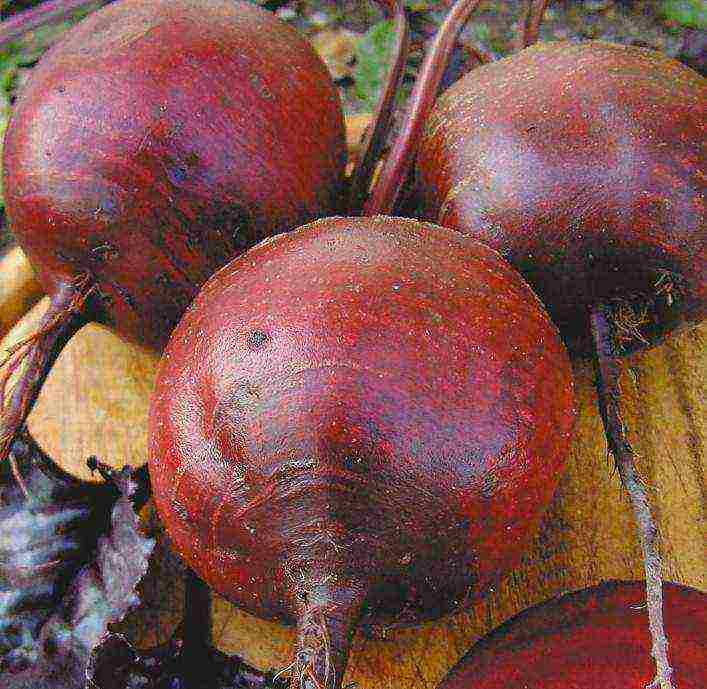
Bordeaux is a medium early beet variety. The full ripening period for this vegetable is 90-110 days. It is one of the best varieties in terms of taste, ideal for use in cooking. The fruits are relatively small, but exceptional specimens reach a weight of five hundred grams. On the cut, the beets have a maroon color, the flesh is sweet and dense. The advantage of the variety, which made it popular, is its simplicity - it is resistant to disease and arid climate. Bordeaux is suitable for long-term storage.
Sowing occurs in late spring. Before planting, the soil is prepared in advance. In the fall, it is fertilized with organic matter, and in the spring, special fertilizers are added.
It is better to wait for good weather, when the earth is at least 10 degrees above zero. Although beets of this species are often planted before winter. It is customary to plant seeds in rows at a distance of 0.3 meters. The sowing depth is approximately five centimeters.
The culture does not require special care other than regular thinning of seedlings and timely watering. Loosening and feeding will ensure fertility. In the fall, even beginners in the gardening business will have a good root crop.
Beetroot "Cylinder"
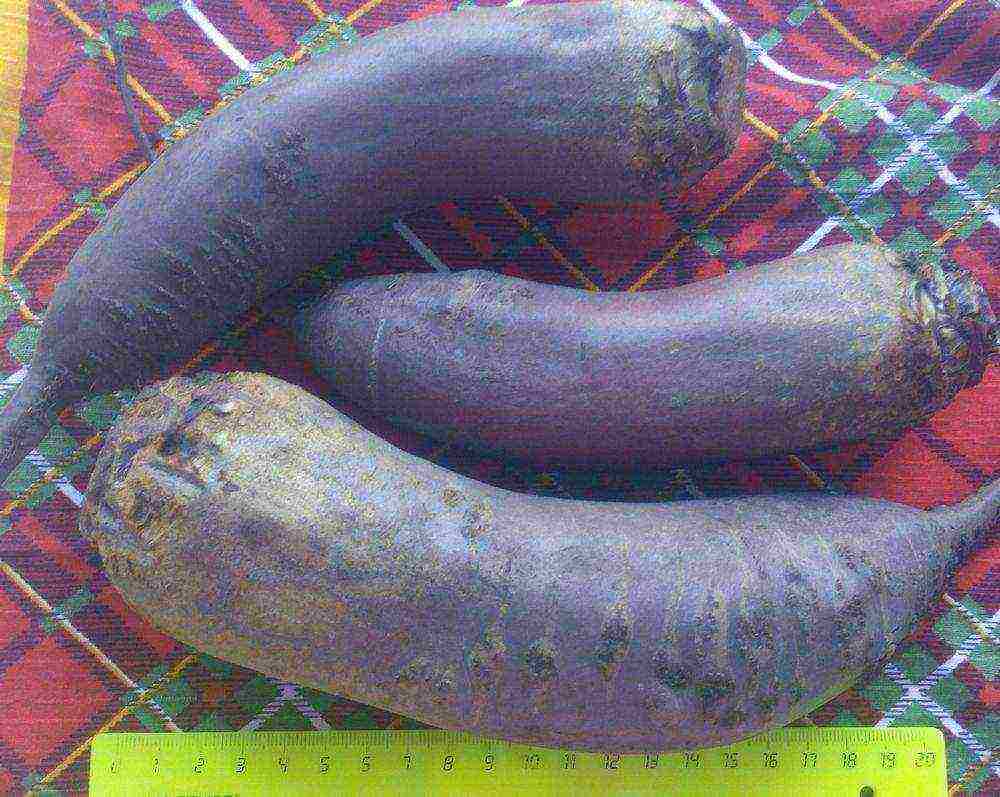
This variety received a similar name due to the elongated cylindrical shape of the root crop. The vegetable reaches an average of 0.2 meters in length, with a diameter of 6 centimeters. The end of the fruit is slightly pointed, the skin is thin. "Cylinder" refers to mid-season varieties, its fruits fully ripen within 120 - 130 days. The mass of beetroot crops reaches 500 grams. Ripe beets protrude slightly above the soil level and weigh about three hundred grams. The pulp is sweet, devoid of ringiness, dark burgundy with hints of purple.
In the spring, immediately before planting, the soil is comprehensively fertilized. Seeds are sown from May to mid-June. Planting depth ranges from two to four centimeters. The "cylinder" is sometimes planted with seedlings, while in April the seeds are placed in the prepared soil. And already in May, the grown seedlings are transferred to the site. It is also customary to plant beets of this variety in rows at a distance of 25-30 centimeters.
Such beets can be stored for a long time without losing their taste, and are distinguished by high yield. Subject to appropriate care, up to ten kilograms of root crops are usually harvested from a square meter of soil.
Photo of the Cylinder beet variety. You can grow larger specimens, it depends on what size is optimal for you.
Beetroot "Detroit"

The variety belongs to the mid-season, high-yielding, is distinguished by the possibility of long-term storage and excellent taste. The pulp is burgundy-red, very juicy and sugar-rich, which led to the widespread use of Detroit beets in cooking. It is from such crops that juices are made. The root vegetable is usually light in weight (up to 300 grams), it is characterized by a rounded shape and smooth skin. From the moment of the first shoots to the appearance of a mature fruit, an average of 125 days pass. The vegetable is resistant to temperature drop and shooting.
The "Detroit" beet seed is planted in mid-spring. Seeds are placed at least seven centimeters apart. High cold hardiness allows sowing also in early November. A distinctive feature of this variety is the need for intense lighting, the root crop does not grow well in the shade. This vegetable is very hygrophilous. Crop care consists of top dressing, regular watering and loosening of row spacings.
Traditionally, the harvest of 9 kilograms per square meter is harvested at the end of September.
Beetroot "Mulatto"

The vegetable is classified as a mid-season variety, excellent storage, high commercial qualities are inherent in it. The ripening time of beets ranges from 120-130 days. The root crop has a regular round shape, bright color, its skin is even and smooth. The weight of a mature vegetable does not exceed 300 grams. "Mulatka" has become widespread for its resistance to various beet diseases, drought and due to its excellent taste. The pulp of the vegetable is tender, juicy, there are no rings on the cut. When cooked, the roots retain their bright red color.
This beet variety perfectly responds to additional soil fertilization. Planting "Mulatto" is carried out strictly according to the schedule - in late April or early May. The row spacing is 30 centimeters, nine holes between the holes. The main care consists in seedling thinning, mineral fertilizing and regular watering.
Loosening the soil will also have a beneficial effect on the harvest, which is harvested in mid-September. It is possible to collect about five kilograms of root crops from a square meter.
Beetroot "Red ball"
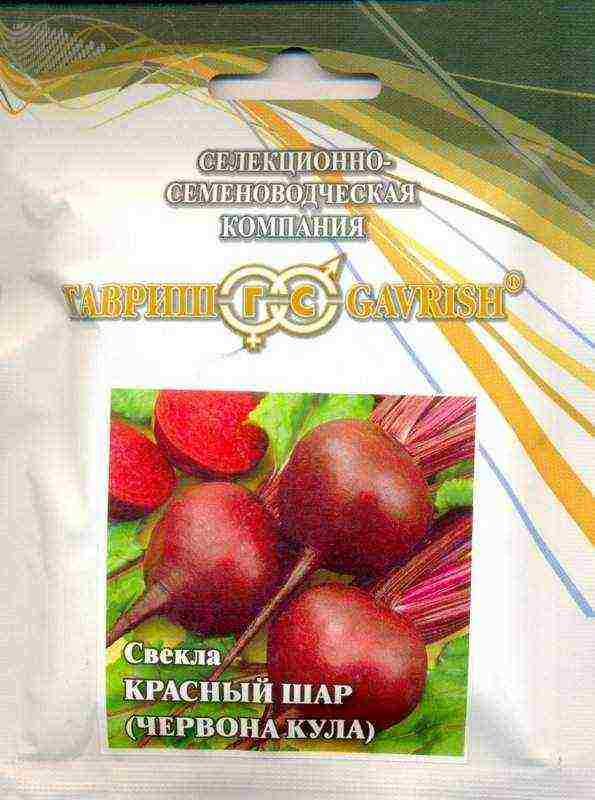
"Red ball" is an early-ripening beet variety, also known for its high yield and commercial qualities. The fruits ripen in a short period, the growing season lasts less than 9 days. Root crops of violet-red color gain weight up to 400 grams, have a round shape. The pulp is tender, almost without rings, cooks quickly, juicy and sweet. By its taste, this variety is considered ideal for baby food. The culture tolerates low temperatures and drought well, rarely suffers from flowering, and is suitable for long-term storage.
With a good harvest, the vegetable responds to the introduction of ash and potassium dressings. Sowing falls in mid-spring. The seeds are placed at a distance of at least 8 - 10 centimeters; it is advised to keep a distance of 0.25 meters between the rows. Watering begins at the first signs of seed germination, focusing on weather conditions. Beets do not like too moist soil, but even with a strong loss of moisture, the pulp becomes tough. Like other varieties of beets, the "Red Ball" needs weeding between rows and loosening the soil.
Harvesting begins in late summer and lasts almost until October.
The benefits of a magic root vegetable
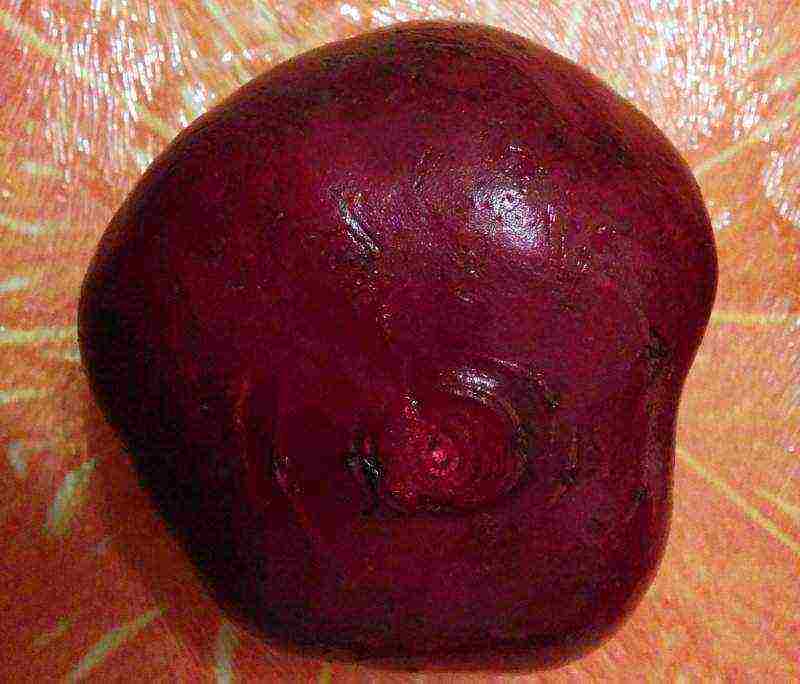
Beetroot is a well-known vegetable, it is a frequent guest on any table. A seemingly simple root vegetable hides a whole periodic table.Beets have a unique composition of nutrients that do not lose their properties during heat treatment. The vegetable contains a number of amino acids necessary for the body, vitamins, trace elements, organic acids, minerals and a huge amount of fiber.
Due to its beneficial composition, beets are used in folk medicine. With its help, runny nose, hypertension, constipation, tuberculosis, skin ulcers, scurvy are treated. The vegetable is used to strengthen immunity, improve metabolism and remove toxins from the body.
However, the root vegetable is most widespread in cooking. It is for this purpose that breeders optimize the beneficial properties of the vegetable and its ability for long-term storage. The correct choice of beet variety will allow you to harvest a decent harvest, as well as enjoy its taste and benefits until next season.
Using the experience and knowledge of the best gardeners, above we have considered the best varieties of root crops.
Vegetables and fruits are practically the only sources of natural vitamins during the cold season. Beets stand out among them for their extraordinary useful composition, so be sure to stock up on this wonderful root vegetable for the winter.
Choose what kind of beetroot planting on your site is not difficult, since there are not too many varieties of it, and literally all of them are high-yielding.
First of all, be guided by exactly when you want to get the root crop harvest.
By maturity beet varieties are subdivided into:
• early (ripen in 50-80 days),
• mid-season (ripen in 80-100 days),
• late (ripen in 100-135 days).
As for the appearance of beetroot, then choose a variety based on the shape and color of the fruit. By form root crops are divided into:
• rounded,
• oval-cylindrical,
• flattened.
Moreover, the choice of form is explained not only by aesthetic preferences. It is believed that cylindrical fruits in the process of growth accumulate much less nitrate-containing substances than flat and round ones. And the preparation for planting their seeds is much easier, since they are not accrete with each other (which is typical for other species), but one-germ.
Shades of beets range from dark red to deep burgundy. True, not so long ago seeds of orange and yellow beets appeared on the market. But getting them is still very problematic.
Beet varieties
And to make it easier for you to decide which table beet is better, we present a list of its most unpretentious and high-yielding varieties, the best according to reviews.
So, what kind of beets to plant in your summer cottage?
| Pablo. This is a medium-ripening, extremely hardy and unpretentious hybrid of beetroot. The fruit is round in shape, up to 200 g by weight, with a thin skin, well stored. The pulp tastes tender, red in color, has no rings on the cut. Pablo beets are recommended by experts for cultivation in the Urals, as they are resistant to early blooming and frost. |
| Bordeaux 237. It is a medium-ripening variety with round dark red fruits, up to 500 g by weight. The pulp is juicy in taste and very healthy, great for cooking and canning. This is one of the best varieties of table beet, as it is famous for its heat resistance, long keeping quality and high yield in any weather. |
| Mulatto. This mid-ripening variety was bred not so long ago, but has already managed to fall in love with Russian gardeners. The root crop is round in shape, smooth to the touch, dark burgundy in color, up to 350 g by weight, retains all its properties during winter storage. The pulp is very juicy and tender, has no rings on the cut, and is red in color. Basically, mulatto beets are used for culinary purposes, because they do not brighten during high-temperature processing. |
| Mona. A medium-sized variety with oval-cylindrical dark red fruits, by weight up to 400 g. The pulp is soft, juicy and tasty, with mild and generally without rings on the cut.Mona is grown for the preparation of various dishes or for further storage. |
| Renova. This variety with high yields ripens late. The fruit is dark pink, oval-cylindrical, leveled, by weight up to 350 g. The pulp has no rings on the cut, rather dense, dark purple. This pink beet can be stored for a long time (up to 7 months) without losing its presentation and taste. |
| Detroit. This is one of the most demanded medium-ripening varieties of cultivated beets among summer residents. The fruit is round in shape, smooth to the touch, red, has no rings on the cut, weight? 250 g. Detroit beets are high-yielding, resistant to early shooting, have a very long shelf life and have an excellent taste. |
| Egyptian. Another, no less popular among domestic summer residents, early ripening variety of vegetable beet. Fruits are flattened, dark red, weighing up to 400 g. The pulp is tasty and juicy, red-violet in color. Egyptian beets are high-yielding, characterized by excellent keeping quality, resistant to drought and shooting. |
| Cold resistant 19. This beetroot for Siberia is the best option, since it is cold-resistant, it sprouts without problems during winter and early spring planting in the garden, it is stored for a long time. The fruit is round, smooth to the touch, dark red in color, up to 250 g by weight. The pulp is healthy and very tasty. The variety is used for cooking and for further storage. |
| Bohemia. This is a medium-ripening variety for round burgundy roots. The pulp is burgundy, has no rings on the cut, juicy, soft and tasty. Subject to the rules of agricultural technology, the fruits of the Bohemian beet grow up to 500 g. The variety is resistant to many pests and shooting, does not need frequent thinning in the process of its growth, and has good keeping quality. |
| Red ball. Popular among summer residents, due to the short ripening period of the vegetable - 72-78 days. Fruits are round, smoothed, weighing up to 250 g, boil very quickly. The pulp is extremely juicy, there are practically no rings on the cut, dark red, the taste is sweet. This variety is recommended by experts for use in cooking and when drawing up a children's menu. |
| Cylinder. This is a mid-ripening variety with oval-cylindrical fruits, up to 16 cm long, weighing up to 250 g. The pulp is tender, dark red, has no rings on the cut. The cylinder differs from other varieties by its high yield, long shelf life and resistance to many diseases that so often affect other hybrids. |
| Vinaigrette Jelly. It is a drought tolerant early ripening variety with round or flat roots, up to 500 g by weight. The pulp is rich red, tasty, dense. During the period of its growth in the garden, the fruit peeps about half above the surface of the earth. Vinaigrette Marmalade, subject to the optimal temperature regime, can be stored for a long time without losing its original taste, which has earned it popularity among summer residents who harvest vegetables for the winter. |
| Black woman. It is a medium-ripening high-yielding variety. The fruit is round in shape, weighing up to 500 g, dark red in color, can be eaten fresh, suitable for further canning. The pulp is purple-red in color, juicy and tender. |
| Bona. This variety is classified as mid-ripening. The fruit is round, smooth to the touch, dark red. The pulp is tasty, has no rings on the cut, and is evenly colored. |
| Dark girl. It is a mid-ripening variety with a flattened dark red fruit. With proper agricultural technology, beets grow up to 500 g by weight. The pulp is reddish-purple, tasty and juicy. |
| One-sprout. It is a medium-ripening beetroot variety with round or flattened fruits up to 600 g by weight. Its main difference from others is the presence of single- and double-seeded fruits, which minimizes the need for thinning young beet sprouts at the beginning of cultivation. The pulp tastes juicy, of a burgundy color. |
| Bon Bon It is a medium-ripening variety with a minimum amount of green mass on the stem.The fruit is round, smooth to the touch, with a thin skin. The pulp is red, tasty. |
| Larka. This mid-ripening variety was brought to us from Holland. The fruit is round, up to 300 g by weight, dark red, stored for a long time. The pulp is juicy, cut without rings, red. According to some reports, Lark's beets, when eaten, are capable of removing radionucleides from the body. |
| Libero. This variety is classified as early ripening. The fruit is round in shape, smooth to the touch, red, up to 250 g by weight. The pulp is red in color, practically without rings on the cut, juicy. Libero beets are resistant to early blooming, are characterized by high yields and fast formation of root crops for bunch products, long shelf life. |
| Nosovskaya flat. The fruits of this medium-ripening variety are flattened, up to 300 g by weight. The pulp is dense, but extremely juicy. Beets are resistant to shooting and high temperatures, they are stored for a long time under certain conditions. |
| Incomparable А 463. This early ripening beet variety is suitable for cultivation in Siberia, as it is characterized by resistance to low temperatures. The fruit is flattened, weighing up to 400 g, red-claret. |
Large selection in the online store of seeds and seedlings:
Beet hybrids
The achievements of breeders have significantly expanded the assortment of table beets, which is now dominated by F1 hybrids - hardy, fruitful, with attractive, tasty, long-stored root crops.
Early maturing: Aksinya F1 (earliest), Elizabeth F1, Zarnitsa F1 (very early), Boltardi F1, Dove F1, Fortuna F1.
Mid-season: Kestrel F1, Eagle F1, Parka F1, Senorita F1, Smuglyanka F1 (mid-late).
With a cylindrical root crop: the family of the famous Cylinder variety has been replenished with new improved hybrids - Daughter F1 cylinders and Granddaughter F1.
Specialized: Isabella F1 - hybrid for extreme growing conditions, Lukerya F1, Miracle F1 - stored until the new harvest, Lyubushka F1 - sweet for juices.
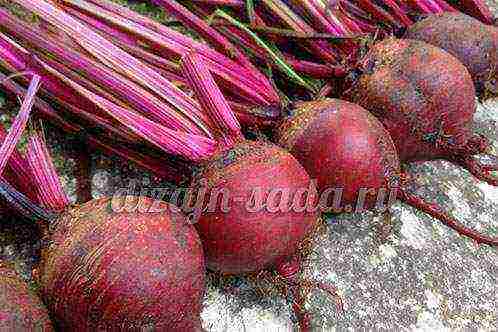
According to the ripening period, beets are divided into early, mid-ripening and late. For winter storage, the second and third are suitable. Early and ultra-early beets are good because they ripen in 2-3 months, but they do not lie well.
Using personal experience, reviews of gardeners from the forum and neighbors in the country, I will describe the best yielding varieties of beets.
The best early varieties of beets, descriptions, reviews
Egyptian flat beet
Early maturing (from germination to harvesting 95-115 days) beet variety. Root crops are flat-round, dark red, weighing 200-400 g. The flesh is red with a purple tint, juicy, good taste.
Advantages of the variety: stable yield, resistance to drought and flowering, suitability for long-term storage.
Egyptian flat sekla is suitable for all types of culinary processing.
Beet yield Egyptian flat: 5 - 8.3 kg per sq.m.
Beetroot Red ball improved
Ultra-early (72-78 days from germination to harvest) high-yield beet variety. Root crops are even, rounded, weighing 150-250 g. Their flesh is dark red, tender, juicy, sweet, almost without rings, quickly cooked.
Advantages of the variety: amicable yield of the harvest, high commercial qualities, good keeping quality. Recommended for home cooking, as well as baby and diet food.
Beet yield red ball: 3 - 6 kg from 1 sq.m.
Bordeaux beet 237
Medium early variety (period from full germination to technical ripeness 95-110 days). Root crops are round, weighing 200-500 g, with dark red pulp and excellent taste.
Advantages of the variety: comparative heat resistance, high yield in all weather conditions, good keeping quality during winter storage. Recommended for cooking and processing. Due to the rapid overgrowth of root crops, later and thickened crops are recommended.
Beet yield Bordeaux 237: 4 - 8 kg from 1 sq.m.
Cold-resistant beets 19
A mid-early variety of beets, the period from full sprouting to technical ripeness is 66-76 days.Root crops are flat-rounded, dark red, smooth, weighing 150-220 g. The pulp is juicy, tender, with excellent taste.
The variety is suitable for growing on a bunch during podwinter and early spring sowing. Used fresh, for processing and long-term storage.
Advantages of the variety: cold resistance, suitability for winter sowing, resistance to flowering, good keeping quality.
Beet yield Cold-resistant 19: 4-7 kg from 1 sq.m.
Mid-season beet varieties, description, photo
Beetroot bohemia
A mid-season variety (70-80 days pass from the moment of germination to ripening) of table beet. Root crops are rounded and flat-rounded, with a dark burgundy color. The pulp is maroon, juicy and tender, without rings, with excellent taste. The weight of one fruit is 300-500 g.
Advantages of the Bohemian variety: resistance to cercosporosis and flowering, does not require thinning, good keeping quality.
Beet yield Bohemia - up to 4.8 kg from 1 sq.m.
Bona beet
High-yielding mid-season beet variety (period from germination to harvesting 115-120 days). Root crops are rounded, large, aligned, smooth, dark red. The pulp is evenly colored, without rings, has excellent taste.
Advantages of the variety: large root crops have high commercial qualities and good keeping quality.
Beet yield of Bona: 5.5 - 6.8 kg per sq.m.
Detroit beet
The most common mid-season beet variety (100-110 days pass from germination to ripening). Root crops of the correct, rounded shape, the same size, with a smooth skin, deep red color, without rings. The weight of the roots is about 250 g. The rosette of leaves is not dense.
Advantages of the variety: resistance to shooting, high yield, even fruits with good commercial qualities, excellent keeping quality. Suitable for both long-term storage and processing.
Beet yield Detroit: 3.6 - 6.9 kg per sq. m.
Beet Incomparable A 463
Medium-early high-yielding, cold-resistant beet variety, 70-100 days pass from germination to harvest. Root crops are rounded and flat-rounded, weighing 170-400 g, dark red with a burgundy tint.
Advantages of the variety: cold-resistant, resistant to flowering and cercosporosis. Possesses good keeping quality.
Beet yield Incomparable А 463: 2.9 - 7.0 kg from 1 sq.m.
Agricultural technology: sowing May 1-15, sowing pattern 30 x 7 cm, harvesting July 25 - September 5.
Beet mulatto
New mid-season variety (from germination to harvesting 120-130 days).
Root crops are rounded, leveled, smooth, maroon color, weighing 150-350 g. The pulp is red, without rings, juicy, tender, with excellent taste. Preserves color when heat treated. Ideal for winter storage.
Sowing with seeds in the ground in late April - early May to a depth of 2-4 cm, with row spacing of 25-30 cm and a distance between seeds of 7-8 cm.
Beet yield Mulatto: 2.5-4.4 kg from 1 sq.m.
The best late varieties of beets, description, photo
Renova beet
Late-ripening, high-yielding variety with long cylindrical dark pink roots. From mass germination to technical ripeness, 100-110 days pass.
Root crops are leveled, weighing 180-350 g, with dark purple juicy, tender, dense pulp, without rings.
Advantages of the variety: good keeping quality for 6-7 months, while not losing taste.
Renova beet yield: 7-9 kg from 1 sq.m.
Beet Cylinder
Medium late (120-130 days) beet variety. Root crops are cylindrical, 5-9 cm in diameter and 10-16 cm long, weighing 180-250 g, with a thin skin. The pulp is juicy, sweet, dark red, without rings.
The Cylinder variety is distinguished by good keeping quality and resistance to the main diseases of beet. Possesses excellent taste.
Cylinder beet yield: 7-10 kg from 1 sq.m.
Beets prefer fertile sandy loam soils. Seeds are sown in the ground in the second half of May.The seeding depth is 2-4 cm, the distance between the rows is 30 cm, between the seeds is 7-8 cm.
Beets are responsive to the application of potash fertilizers, ash. During the entire growing season, loosening of row spacings, weeding, thinning of seedlings is carried out. Water the beets depending on the weather conditions, they do not tolerate waterlogging.
For winter sowing, seeds are sown at the end of October to a depth of 4-6 cm.
The best precursors for beets are early potatoes, onions, cucumber, pumpkin, and squash.
We recommend purchasing beet seeds of excellent quality in the Sady Rossii online store.
